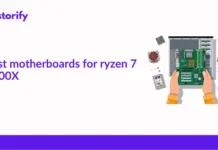This post covers the list of Best Laptops for Video Editing Under $1000.
Any blogger worth following understands the rigors of video editing. And it’s not just a matter of locating a machine with a capable graphics card.
No, the problem is finding the optimal combination of high-end specs, ranging from stunning discrete graphics and intelligent CPUs to high-quality resolution.
Contrary to popular belief, finding a low-cost video editing laptop is quite feasible. Some of the finest laptops for video editing under 1000 dollars will work just as well, and their cheap price allows you to save money for other essential things.
Of course, a desktop computer is excellent for video editing work and may even be more affordable than a laptop.
However, travel vloggers have an additional burden of choosing excellent laptops for travel that combine dependability and robustness with the mobility demanded of the finest tool for producing distinctive video on the move.
Contents
- Things to Consider in a Laptop for Editing Videos
- 1. Monitor Screen Quality:
- 2. Audio:
- 3. Graphics Transition Card:
- 4. RAM:
- 5. Processor:
- 6. Storage Speed:
- 7. Storage Space:
- 10 Best Laptops for Video Editing Under $1000
- 1. HP Pavilion Flagship
- 2. Samsung Notebook 7
- 3. HP Pavilion Gaming
- 4. Asus TUF Gaming Laptop
- 5. ASUS Zenbook 13
- 6. Lenovo Ideapad L340
- 7. Asus Vivobook S15
- 8. Acer Nitro 5
- 9. Dell Inspiron 15 5505
- 10. Dell G3 15
- FAQs
- Q. Is it possible to edit 4K footage on a laptop with a 1080p display?
- Q. What amount of RAM do I need to edit the 4K video?
- Q. Is 32 GB of RAM excessive?
- Conclusion
- Also Read:
Things to Consider in a Laptop for Editing Videos
1. Monitor Screen Quality:
Consider the most delicious pie you’ve ever eaten; monitor displays are precisely like that. You don’t realize how much you need them until you get one.
Additionally, being the first to appreciate your work necessitates seeing it in its purest form, which nothing accomplishes better than high-quality screen resolution.
It’s worth noting that identical screen sizes may have wildly varied resolutions, and vice versa. Therefore, talk less about the width of the screen and more about its clarity.
For vloggers, there is an added incentive to look for features like anti-glare displays. Anti-glare screens are thin films composed of specialized materials that are applied to the surface of computer displays to create additional layers.
This film serves as a reflector against the sun’s beams. It may mean the difference between decent work and a wonderful piece of art for individuals on the go.
2. Audio:
Oftentimes, the distinctive aspect of travel vlogs is their unique content. Having inadequate audio support for a well-edited video degrades the appearance of the visuals. As a result, your chances of communicating successfully decrease, not just with yourself, but also with your audience.
It may be compromised, but there is no need to accept less
3. Graphics Transition Card:
As with every other piece of technology, there are many classes of graphics cards. For video editing, you’ll need a graphics card that can match Barry Allen’s pace.
4. RAM:
From this, you may infer that if you need a big hard drive to keep your stored data, it is also critical to have enough RAM to allow for real-time video editing and playback. A typical habit is to dedicate a portion of your memory to your job in order to maximize your enjoyment of your work experience.
While 8GB is a good starting point, 16GB or more is recommended. Keep in mind that RAM can be increased very inexpensively if you find a good bargain, although it is a bit low.
5. Processor:
For individuals who thrive on multitasking, a dependable processor is an essential tool. Many experts believe that a CPU is more important than a specialized graphics card when it comes to video editing since the duties often place a high demand on processors and memory.
While searching for a system with a decent processor may be challenging, a good rule of thumb is to go for a processor with a high thread count.
6. Storage Speed:
Typically, there is a trade-off between storage capacity and speed, and with reason.
Because the speed of your hard drive dictates how quickly you can do tasks, it may be very infuriating to spend hours staring at the program logo when you could have exported your video immediately with a quicker machine.
There is, of course, the well-known technique of storing all applications and media files on different drives to increase performance, but there is no replacement for a fast hard disk.
When a portable device’s battery runs out, it loses its use and becomes a burden. That is why the battery life of a gadget is a critical consideration in its selection. That is all.
7. Storage Space:
The core of a portable system is its plenty of storage. At home, you may have access to external hard drives and the like, but they become too big for travel vloggers who need to keep things light, particularly when you’re going to forget them. Offline video editing software requires a significant amount of storage space.
As a result, it becomes critical to have enough storage on your laptop, and a large hard drive is a smart place to start. Additionally, if you travel often, I suggest a solid-state drive (SSD) over a conventional hard disk.
Although the increased performance and speed of an SSD are offset by the fact that they often have less storage capacity than a conventional hard drive for the same price.
10 Best Laptops for Video Editing Under $1000
1. HP Pavilion Flagship
Hewlett Packard was not kidding when they released one of the finest laptops for video editing around $1,000.
The specifications will astound you, with an incredible 12 GB RAM working in tandem with an Intel Core i5-8300H CPU and an NVIDIA GeForce GTX 1050 to create a dependable brain capable of shattering the toughest barriers, at least on paper.
In actuality, it is a bit less dramatic, but still very powerful.
HP’s Pavilion Flagship’s battery life likewise deserves a passable grade, nothing more or less. Its hard disk is a terabyte in size but has slow transfer rates, but it is future-proof with enough type C USB ports in a complete deck that includes an earphone jack and an HDMI connection, which is very good for a budget video editing laptop.
Features and Benefits –
- Expansive Storage
- Works and plays cool
- Elegant design
- Strong performance all-round
- 15.6-inch screen
- 12 GB RAM
- Core i5-8300H processor unit
Pros:
- Good enough keyboard
- Enhanced case rigidity
- Touchscreen
- Low operating temperatures
- Good speakers
Cons:
- Less battery life.
- Display lacks brightness.
2. Samsung Notebook 7
Despite the path that Samsung laptops have taken in the past, it is becoming apparent that Samsung is losing faith in laptop design. The Samsung Notebook 7 13.3″ does little to dispel that impression.
However, if you look beyond the exterior, the Notebook 7 delivers on performance with up to 16 GB of RAM, a Core i7 CPU, and a robust 256 GB SSD hard drive that can be expanded to 512 GB if necessary.
That said, it is maybe only slightly quicker at transcoding 4K to 1080p movies than some other laptops in its class, and it runs hot enough with a basic graphic card to make it difficult to swallow, but that is not to say it does not farm videos effectively.
With 13+ inches of white balance accuracy and color reproduction, the Samsung Notebook 7 defends itself when it comes to screens.
Additionally, its screen quality is not a sham, outperforming itself with an immaculate clarity that will wow even those with little to no experience with displays. What counts is that the Notebook 7’s mediocre quality is acceptable for the price and sufficient for certain degrees of video editing.
Features and Benefits –
- Good enough storage and okay performance
- Smoothly transitions between its 2-in-1 design modes
- Doesn’t heat up
- Has a crisp display that has little competition
- 13.3 inches display
- 16 GB RAM
- 256 GB SSD
Pros:
- Good enough keyboard
- Enhanced case rigidity
- Touchscreen
- Low operating temperatures
- Good speakers
Cons:
- No SD Card reader.
- Odd speaker placement.
3. HP Pavilion Gaming
The device is equipped with an Intel Core i7-8550U 8th generation quad-core CPU that enables multi-track editing and other resource-intensive activities.
Additionally, the device has an Integrated HD Graphics 620 card, which enables 3D modeling and graphics-intensive gaming
Video editors would like this unit’s 32 GB DDR4 RAM the best. This amount of RAM capacity will remove any delays that may arise while editing. Apart from that, the device has a 2TB hard drive, which is excellent for editors.
A disadvantage is the absence of an SSD, which may result in a sub-$1000 budget.
Features and Benefits:
- Sufficient battery backup
- FHD touchscreen panel
- Sleek design
- 2.4 GHz Intel Core i5-9300H processor
- 15.6″ micro-edge display
- Full HD 1920 x 1080 native resolution
- 256GB SSD.
Pros:
- Superior performance
- Great design
- Amazing keboard I/O
Cons:
- Low battery life
- 60 Hz refresh rate
4. Asus TUF Gaming Laptop
The ASUS TUF is an excellent option for video editors and a capable gaming laptop from a variety of manufacturers.
If you’re just starting started with video editing, the ASUS TUF is an affordable choice. A well-built laptop with the essential specs and improved graphics performance.
This laptop is the most spacious in this price range and the best for displaying 4K material. It has an Intel Core i5-8300H CPU with a maximum clock speed of 3.9 GHz, making it ideal for sophisticated 3D gaming and demanding video rendering.
Features and Benefits
- Aggressive cooling tech
- Hybrid storage
- Rugged build
- 1 TB SSD
- 8 GB DDR4 RAM
Pros:
- Very reasonable price
- Amazing keyboard look
- Fast CPU and processor up to 3.9 GHz
Cons:
- Runs hot with time
5. ASUS Zenbook 13
The ASUS ZenBook 13 is a well-balanced package of nearly everything you want in a laptop.
If you’re looking for a laptop that’s capable of editing but also functions as a general-purpose computer, you should consider this model. As with previous ZenBook devices, this one combines a long battery life with a portable design.
As with the notebook we previously reviewed, the ZenBook 13 is powered by an Intel Core i5-8250U, an Ultrabook-focused CPU capable of withstanding moderate strain. Turbo Boost speeds of up to 3.4 GHz are also possible.
Therefore, if you utilize an application that is heavily reliant on CPU resources, you may anticipate an outstanding performance from this card. Additionally, this bundle does not include specialized graphics.
Features and Benefits –
- Excellent battery life
- Sleek and lightweight
- Impressive connectivity
- Intel Core i5-8250U
- 8 GB of DDR4 RAM
- 3.4 GHz on Turbo Boost
- 256 GB of SSD storage.
Pros:
- High-quality metal case
- IPS display
- High display brightness
- Matte display
- Powerful speakers
Cons:
- No thundebolt
- Average keyboard.
6. Lenovo Ideapad L340
If you prefer a gaming laptop for video editing, the Lenovo Ideapad L340 is a good option. It’s a remarkable blend of speed, specialized graphics, and the essential tools for hassle-free video editing.
The same is powered by an Intel Core i5-9300H CPU from the 9th generation. With a basic clock speed of 2.4 GHz, this CPU delivers impressive hexa-core performance without sacrificing battery life.
As previously said, this gaming-friendly laptop has a 4 GB VRAM NVIDIA GeForce GTX 1650. While this will not provide you with high-end visuals, it will be enough for animation and some 3D rendering.
Benefits and Features –
- Gaming-grade keyboard
- Portable, sleek design
- Gaming-friendly performance
- 9th Gen Intel Core i5-9300H processor.
- the base clock speed of 2.4GHz
- 15.6-inch full HD panel
Pros:
- Affordable pricing
- Excellent Battery Life
- Powerful design
- Fast graphics and processor
Cons:
- Dull design.
- Not very durable.
7. Asus Vivobook S15
The Vivobook series first established a reputation for itself as a super-thin Windows PC notebook comparable to Apple’s MacBook Air, but for a far lower price.
However, the Vivobook has developed a personality of its own and is now available in an infinite number of configurations. However, great value hasn’t gone away, with the Vivobook S15 providing enough processing power for less than $1000, making it ideal for video editing on a budget.
The Vivobook S15 is powered by an Intel Core i7-8565U from the 8th generation. The processor’s clock speed may be increased to 4.6 GHz. Additionally, it has a 8 MB cache, which significantly speeds multi-tasking. The additional cache and cores are very beneficial when editing video.
Features and Benefits
- The mammoth battery life of 14 hours.
- The 13.3-inch wide-view Full-HD has nano bezels.
- Fast 8GB LPDDR3 RAM.
- It features a fast 512GB SATA SSD.
- The processor speed can be boosted up to 4.6 GHz.
Pros:
- Comes with both an SSD and a HDD
- Backlit keyboard.
- 178 degree viewing angle.
- Fast fingerprint sensor.
Cons:
- VGA webcam only.
- Small battery capacity.
8. Acer Nitro 5
Not everyone is a gamer. However, you must agree that gaming laptops offer some of the finest specifications for creative activities such as video editing. And at the $1000 price point, we found just one laptop that might possibly outperform the others: the Acer Nitro 5.
The Acer Nitro 5 has an impressive performance segment. It is powered by an Intel Core i5-9300H processor from the 9th generation.
The processor’s clock speed may be increased to 4.1 GHz. Additionally, you won’t have to worry about your laptop overheating, since it includes Acer CoolBoost technology.
Features and benefits –
- Decent battery life of 8 hours.
- 8GB RAM and 256 GB NVMe m.2 SSD
- 2 x PCIe M.2 slots.
- 15” FullHD (1920×1080) display
- Up to 4.1GHz clock speed.
- It features a 9th Generation Intel Core i5-9300H Processor.
Pros:
- Fast SSD Storage
- Backlit keyboard
- Great battery life.
- Upgradable options for RAM and SSD.
Cons:
- Only 60 Hz refresh rate.
9. Dell Inspiron 15 5505
This laptop is very well-built and designed. Additionally, its specs and design will remind you of the XPS series because of its superior build quality. Indeed, we are discussing the Dell Inspiron 15 5505.
Dell has made significant improvements to the Inspiron series over the years, and it is now very close to matching the premium XPS range. However, the advantage of this laptop is that it is reasonably priced, coming in just under our target price of $1000.
This particular laptop has a standard 15.6-inch Full HD anti-glare display with 300-nit brightness. Additionally, the display on this laptop provides excellent color space coverage.
It supports 72 percent of the NTSC or 100 percent of the sRGB color spectrum, which results in more accurate color grading and a true-to-life video preview.
Features and Benefits –
- Decent Body Construction
- Color-Accurate Display
- 512GB NVMe SSD
- AMD Ryzen 7 4700U
- 15.6-inch 1920 x 1080p FHD.
Pros:
- Flexibile design.
- 3 GHz clock speed.
- Plenty of configurations
- Great speakers.
Cons:
- No USB-C ports
- Low HD screen.
10. Dell G3 15
This is the machine that is most suggested if your budget is limited. It is available for much less than $1000, even as low as $800, making it one of the most inexpensive options for powerful hardware.
The laptop is powered by an Intel Core i5 10300H CPU running at 2.5 GHz with a quad-core architecture. Without a question, this CPU is capable of handling whatever task you throw at it.
Additionally, this laptop has a dedicated Nvidia 1650 Ti graphics card with 4 GB GDDR6 Video RAM.
Additionally, it has a 15.6-inch Full HD display with excellent viewing angles. RGB coverage, on the other hand, is poor, yet it provides acceptable color accuracy. This is a glare-free display that resists color fading in direct sunlight.
Features and benefits –
- Dedicated GPU
- Good processing power
- Reasonable price
- 512GB NVMe SSD
- 8GB DDR4 2933MHz
- 15.6-inch FHD at 144Hz refresh rate
- Intel Core i5-10300H
Pros:
- Great battery life
- Good cooling
- 2x SODIMM slots
- Lightweight
Cons:
- Dim display
- Clunky touchpad.
FAQs
Q. Is it possible to edit 4K footage on a laptop with a 1080p display?
Ans: Yes, you can edit 4k footage on a laptop with a 1080p display. Your monitor’s or screen’s resolution is 1080p. To edit video, you’ll need a powerful computer, not a high-resolution screen.
Q. What amount of RAM do I need to edit the 4K video?
Ans: A minimum of 16 GB of RAM is sufficient for HD editing, while 32 GB or more is required for 4K or 6K editing. Because data must be rapidly available to the CPU and RAM, storage performance is critical. Otherwise, depriving the CPU and RAM of data results in poor performance, regardless of the speed of the other components.
Q. Is 32 GB of RAM excessive?
Ans: Yes, in general. The only reason an ordinary user would need 32 GB is to ensure future compatibility. In terms of pure gameplay, 16 GB is plenty, and you can get by just fine with 8 GB.
Conclusion
We live in an era in which digital video has become very easy to disseminate through a plethora of internet channels. The film is an innately great tool for anything from business marketing to just sharing information within a community, and if you can produce a high-quality video with a professional touch, you’re likely to find an audience.
To effectively produce, edit, and master digital video requires not just a high-quality camera, but also extensive knowledge of video editing tools such as Adobe Premiere, Final Cut Pro. and DaVinci Resolve.
Additionally, you’ll need a machine with sufficient processing power to operate the program and avoid crashing while working on more sophisticated projects that may include numerous video clips, pictures, music, and fancy effects.
When it comes to selecting a laptop for video editing, it’s self-evident that the most costly, most powerful contemporary computers will provide the greatest flexibility for creating and editing complicated video projects, including those produced in 4K quality.
If your budget is slightly limited, such high-end laptops will simply be out of reach. However, with the dropping costs and growing speed of computer technology, even investing as little as $1000 on a new laptop, you can anticipate a specification that is more than capable of video editing.
Affordable contemporary laptops now have technology capable of running video editing applications. Expect a quad-core CPU, lots of storage and memory, and perhaps even a separate graphics card to fit inside the budget, all of which will offer a significant speed increase while editing video.
To be sure, you may not be able to work with 4K footage and will instead need to edit at a lesser quality of 720p or 1080p. However, the specification of a video editing laptop under $1000 should have no effect on your creativity, and you should be able to bring your ideas to reality regardless of your budget.
Also Read:
- 10 Best Laptops for College Students Under $500 in
- 15 Best Gaming Laptops Under $1000
- 8 Best Gaming Laptops Under $2000 in
- 5 Best Laptops for Video Editing Under $1500
























